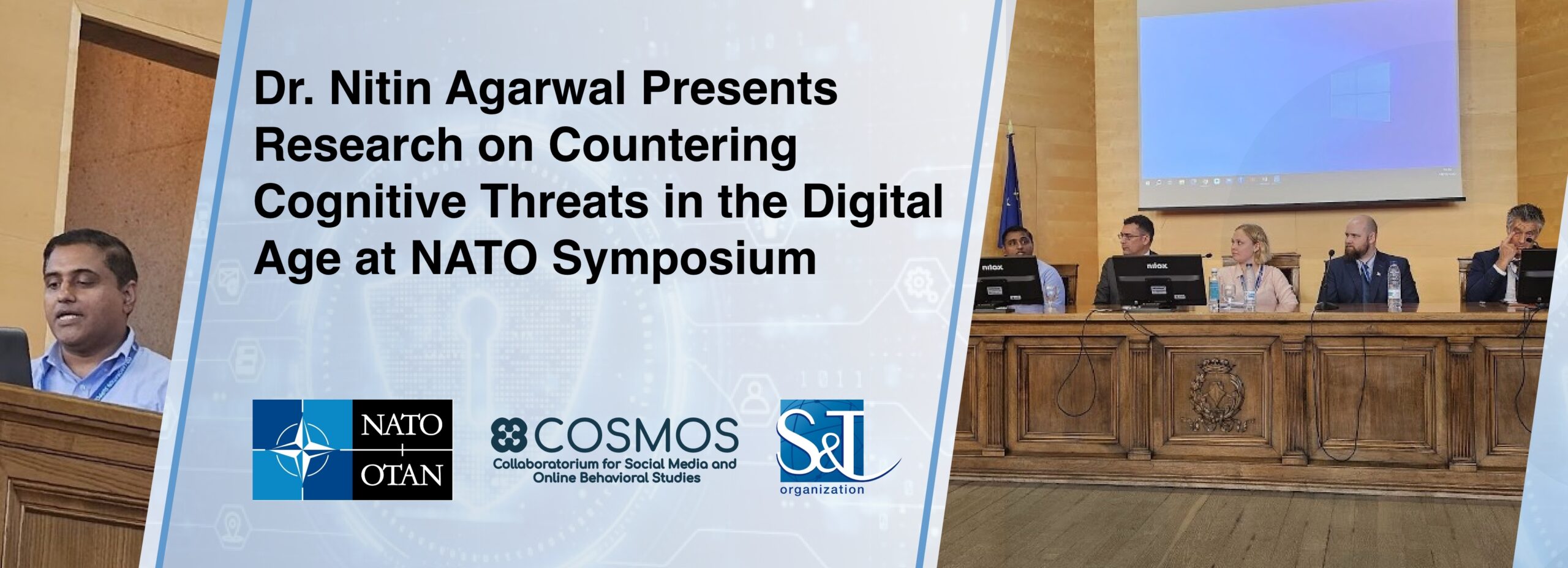When it comes to the international stage, conflicts may arise between distant countries, oftentimes leading to fighting by proxy or in and through affiliated countries, such as the case in the current Ukraine war. For example, in the recent conflicts in Ukraine, a current issue is how countries like the US or organizations like NATO fund and support troops on the ground from afar. In this regard, cognitive warfare has become a keystone of the modern military, and COSMOS’ director Dr. Nitin Agarwal’s research, which he presented to NATO this November, has informed both NATO and general military operations.
Cognitive warfare has existed for as long as there has been an intersection between technology and war. In their 2022 technical report, NATO’s Science & Technology Organization Human Factors and Medicine exploratory team 356 (STO-TR-HFM-ET-356) titled “Mitigating and Responding to Cognitive Warfare” used the example of famous WWII fighter pilot John Boyd. In his study of military history and from his experience as a pilot, Boyd noted how successful war tactics went beyond simple strength and force—tactics like deception, speed, and fluidity of action could turn a conflict just as much; in his own words, these were the tactics that caused an enemy to “unravel before the fight,” and from this he created a military strategy termed the Observe-Orient-Decide-Act (OODA) loop. Success in conflict stems from the ability to do each of these things—and research must continue to learn how cognitive warfare develops with new technology.
And such warfare, in our technological age, has progressed significantly, now that the Internet and social media connect peoples of different countries while opening countries to cyber attacks. NATO has for several years recognized the importance of research on cognitive warfare of this nature, and for this reason, NATO has sought to define cognitive warfare, which, in their ET-356 report, is warfare which “gives rise to the adversaries’ ability to shape human cognition, perception, sensemaking, situational awareness, and decision making” and that “aims at disrupting relationships and targets human vulnerabilities, such as trust and cognitive bias.” Prior to this report, they had identified the importance of cognitive warfare in conflicts with non-NATO countries, reflected in a statement issued at the 2021 NATO Summit Brussel saying, “We are increasingly confronted by cyber, hybrid, and other asymmetric threats, including disinformation campaigns, and by the malicious use of ever-more sophisticated emerging and disruptive technologies….. We remain concerned with China’s frequent lack of transparency and use of disinformation ….. Russia and China fully engaged in this type of Warfare.” In particular, they note the developing technologies of Artificial Intelligence (AI), Machine Learning (ML), and Information Communication Technologies (ICT) as key to the cognitive warfare of the new era; for this reason, they created their “CogWar House Model”, which formed the theoretical basis for future research seeking to improve OODA cyber operations. Of note are the “pillars” of knowledge the model looks to: neuroscience, cognitive & behavioral science, and social & cultural science.
At the NATO Science & Technology Organization Symposium on Mitigating and Responding to Cognitive Warfare (STO-MP-HFM-361), international researchers convened in Madrid, Spain from November 13th to 14th on what the research now shows. There Dr. Nitin Agarwal presented research that combines behavioral science with social science through novel social computing methods. “Propaganda disseminated through social media could potentially be used to persuade susceptible targets to disrupt or delay military operations through protests or other “non-lethal” resistance,” he proposed, “Narratives can be easily manipulated and influenced by bots, trolls, and other influence operation tactics, techniques, and procedures, or TTPs.” Moreover, he highlighted that, “most users of social media cannot or will not differentiate between legitimate and non-legitimate accounts” and that “since such influence operation TTPs can be employed clandestinely in a low-cost, low-risk context, military leaders can expect to encounter an increased amount of adversary-generated AI-amplified social media-driven propaganda.”
Dr. Agarwal also noted that socio-cognitive threats are increasingly becoming (1) a collective phenomenon and (2) multimedia online information environment centric. Building upon the HFM ET-356 House Model, his study aims to advance social, behavioral, and cultural science and enhance situation awareness and sensemaking—most notably, by using real-life datasets to confirm algorithms that detect, examine, evaluate, measure, and, most importantly, predict cognitive threats like adversarial information campaigns. Namely, Dr. Agarwal used data from COVID-19, the Indo-Pacific region, and his participation during various NATO exercises dating back to 2013.
His research develops a multi-model, multi-theoretic approach that blends computational modeling, big ‘social’ data, and social science theoretical principles to characterize adversarial information campaigns conducted in a multi-platform and multimedia-rich online information environment. This research identifies key actors, groups/mobs, narratives, TTPs (and their impact), in mainstream platforms as well as emerging and multimedia-rich platforms to characterize information actors (producers and consumers) and campaign dynamics for proactive decision-making to mitigate cognitive threats.
Cognitive warfare is classified as the sixth warfighting domain beside land, sea, air, space, and cyber. Cognitive threats via mis-, dis- and malinformation, bots, and AI have already become a key element in conflicts between the US, China, Russia, and Ukraine. Dr. Agarwal’s research confirms that NATO and other affiliated countries can, indeed, effectively combat the effects of these adversarial tactics and new technologies, and researchers like him continue to inform policymakers. He thanks the NATO Science & Technology Organization for having him and for the opportunity to share his and COSMOS’ work on developing socio-computational approaches to mitigate socio-cognitive security threats.

